Level Up 01: Reporting with Papaja
SeminRs
Informal, optional weekly sessions to help build a 'portfolio of skills'
1-2 hours of instruction, demos, walk throughs & activities to try out
Essentials
- Focused on the fundRmental skills to help you get started with learning R
- Covering: basic wrangling & visualising data, 'pretty' R Markdown, inline code, debugging...
Level Up
- Focused on more advanced programming skills & applying these skills to new fun topics
- Covering: Papaja, advanced wrangling & manipulation of data, 'even prettier' R Markdown, spotifyR...
Session topics are not fixed - use the Padlet linked on Canvas for suggestions!
Suggested Workflow
Create an R project file for all seminR sessions
Within this directory, create an r_docs & data folder
Save all Rmds and datasets to these folders respectively
File > New Project... New Directory > New Project > Give your project a name & location
- Make a cheat sheet of useful functions and # comment their meaning and usage as you go through seminRs, practicals, tutorials etc.
Session Objectives
Reporting with Papaja
Intro into Papaja for reporting
Guided Papaja install
Useful Papaja functions & tools
Referencing with Papaja, citr, & BibTeX
Tips & Tricks
Papaja: Preparing APA Journal Articles
R package created by Frederik Aust & Marius Barth for producing APA style papers/reports
R Markdown template
Renders to pdf or Word doc
Combine your analyses & write-up in a nicely formatted APA-style document
Under active development
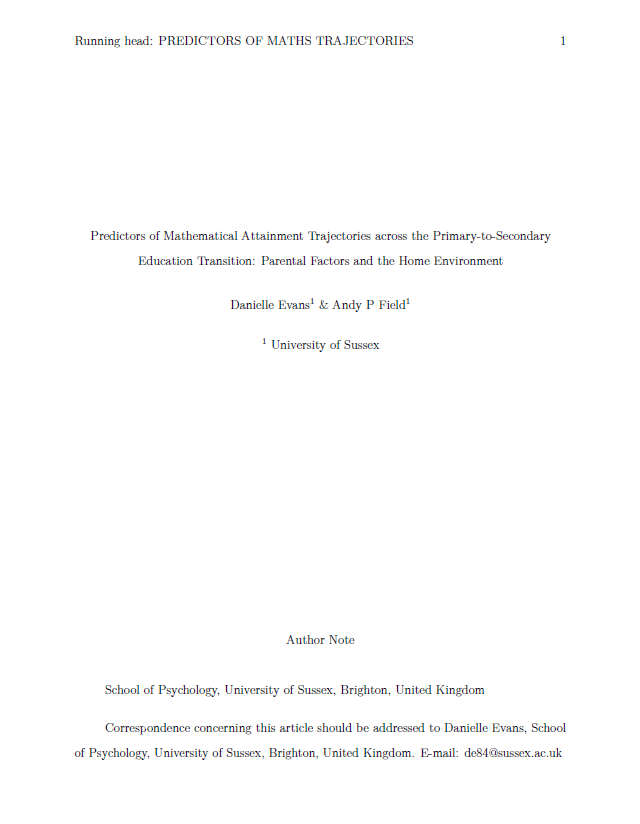
Why bother?
Replication crisis
Good for reproducibility & open science
Anyone with the data & scripts can reproduce your results
Saves time on formatting in line with APA guidelines
Automatic reporting & updating of results
Contains useful functions & tools for formatting tables, statistical test results & references
Guided Install
Prerequisites:
R (2.11.1 or later) and RStudio (1.1.453 or later), to check run sessionInfo() & go to Help > About RStudio
Installing TinyTeX
- Needed for rendering Word & pdf docs
if(!"tinytex" %in% rownames(installed.packages())) install.packages("tinytex")tinytex::install_tinytex()Installing papaja
if(!"devtools" %in% rownames(installed.packages())) install.packages("devtools")devtools::install_github("crsh/papaja")Usage
File > New File > R Markdown... > From Template > APA article
Very similar to standard R Markdown files
3 main components:
- YAML for document meta data
- Markdown for your main write-up
- Code chunks for R code

YAML Options
First part contains meta data needed for journal submissions
Can delete out any irrelevant options (i.e., author role, address, affiliation etc. for assignments)
Edit info as you would in a normal Rmd
The second part of the YAML contains additional options, 3 of which you'll most likely want to change:
bibliography: ["your_bib_file.bib", "r-references.bib"]
floatsintext: yes
linenumbers: no
output: papaja::apa6_word to render to a word doc
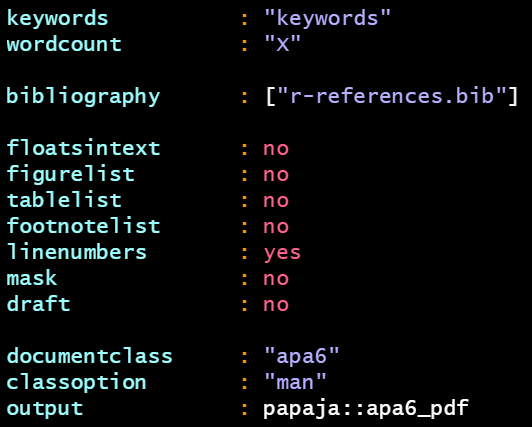
Useful Functions & Tools
printp() to report p-values in APA style using inline code
This:

Renders as:
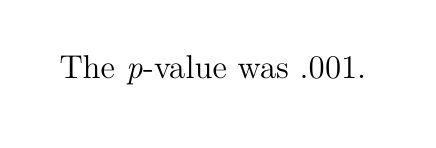
apa_print() to report the results from various statistical methods in APA
This code:
out <- apa_print( t.test(yield ~ N, data = npk))
& This inline code:

Produces this output:
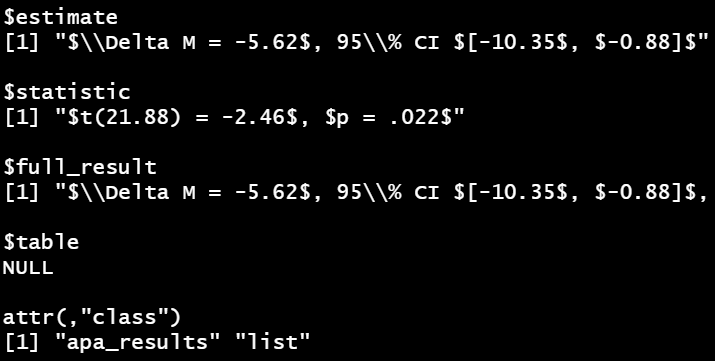
Renders as:

apa_table() to report the statistical tests in an APA style table (apa_table() extends knitr::kable())
Example code:
# for ready made tablestable %>% dplyr::select(Effect, Estimate, ci, StdEst, p) %>% apa_table(., caption = "Model parameters for predictors of the intercept of maths attainment (at age 11).", col.names = c("Predictor", "$b$", "95\\% CI", "$\\beta$", "$p$"), escape = FALSE, digits = 3, note = "$\\beta$ is the standardized parameter estimate." )Example output:
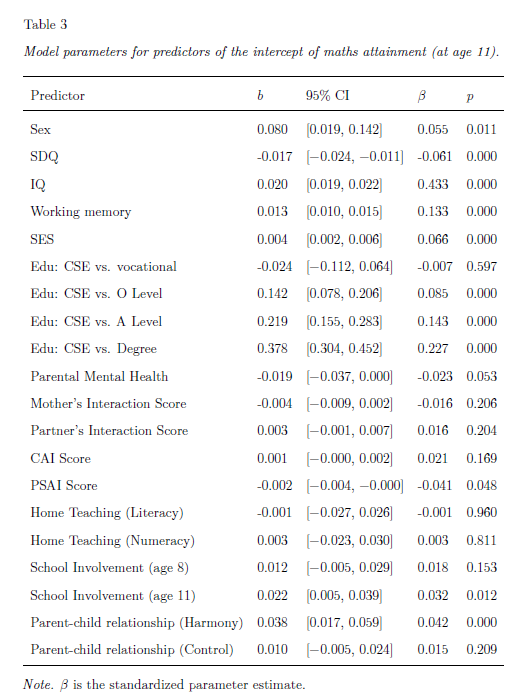
apa_table() to report the statistical tests in an APA style table (apa_table extends knitr::kable())
Example code:
# for raw results from testsapa_lm <- apa_print(lm_out) # creates table element you can subset using $ apa_table( apa_lm$table, caption = "A full regression table." )Example output:

theme_apa() to format plots made my ggplot2 in APA style
This:
plot <- ggplot2::ggplot(peng_data, aes(species, flipper_length_mm))plot + stat_summary(fun = "mean", geom = "point", size = 4, position = position_dodge(width = 0.3)) + labs(x = "Species", y = "Flipper Length (mm)") + coord_cartesian(ylim = c(0, 250)) +scale_y_continuous(breaks = seq(0, 250, 50)) + theme_apa()Becomes:
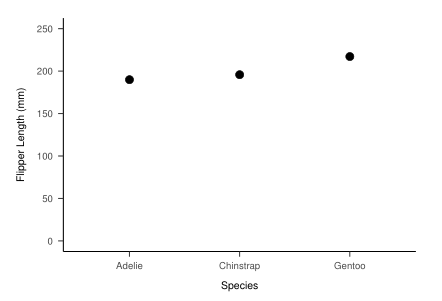
cite_r is a function in papaja for citing R packages, the code needed to generate them is provided in the template under the data analysis section, all you need to do is load your packages & they'll be added to the r-references.bib file automatically & included in the reference list
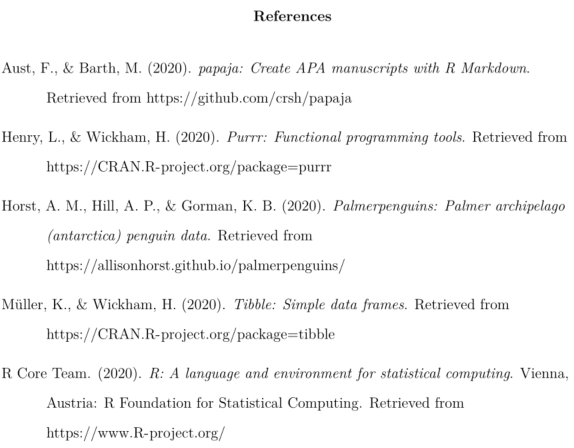
Bibliographies & .bib files
BibTeX files (.bib) are a text based file format for bibliography items (i.e., articles, books, URLs)
You can create them by creating a plain text file and saving it with a .bib file extension

Give the name of your .bib file in the YAML & add your references as you go
The Google Scholar Button for chrome is an easy way to get BibTeX references, but double check these are correct & complete
How to cite
- Using the names of references in your .bib file that you've specified in the YAML:
bibliography: ["your_bib_file.bib", "r-references.bib"]
- Cite following these examples*:

[*] Examples taken from the papaja manual
Tips & Tricks
Make sure your references are correct as you go - don't leave it until you have 100 references to check the page numbers of
Errors can be difficult to solve, knit your Rmd often & get help as early as possible if you're stuck
No duplicate chunk labels allowed - this will cause an error
Don't install packages in your code chunks - use the console
By default, papaja sets global chunk options to echo = F (code is run but hidden) & messages = F, sometimes you might want to set warnings = F too
papaja reports all numeric values written using inline code to 2 dp by default
To report equations, enclose in $
References of '???' highlight errors, check it exists in your .bib file & check your spelling in your Rmd